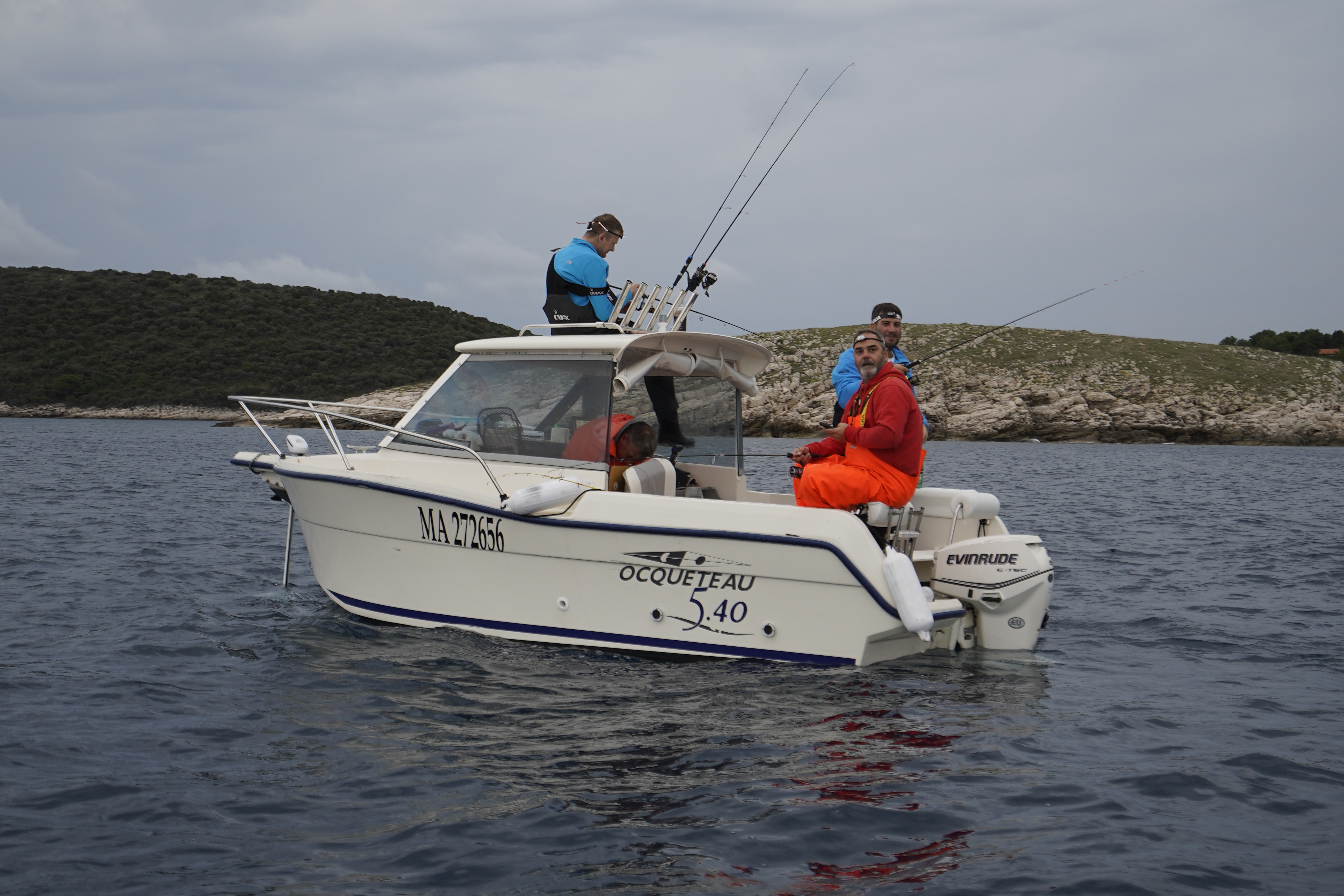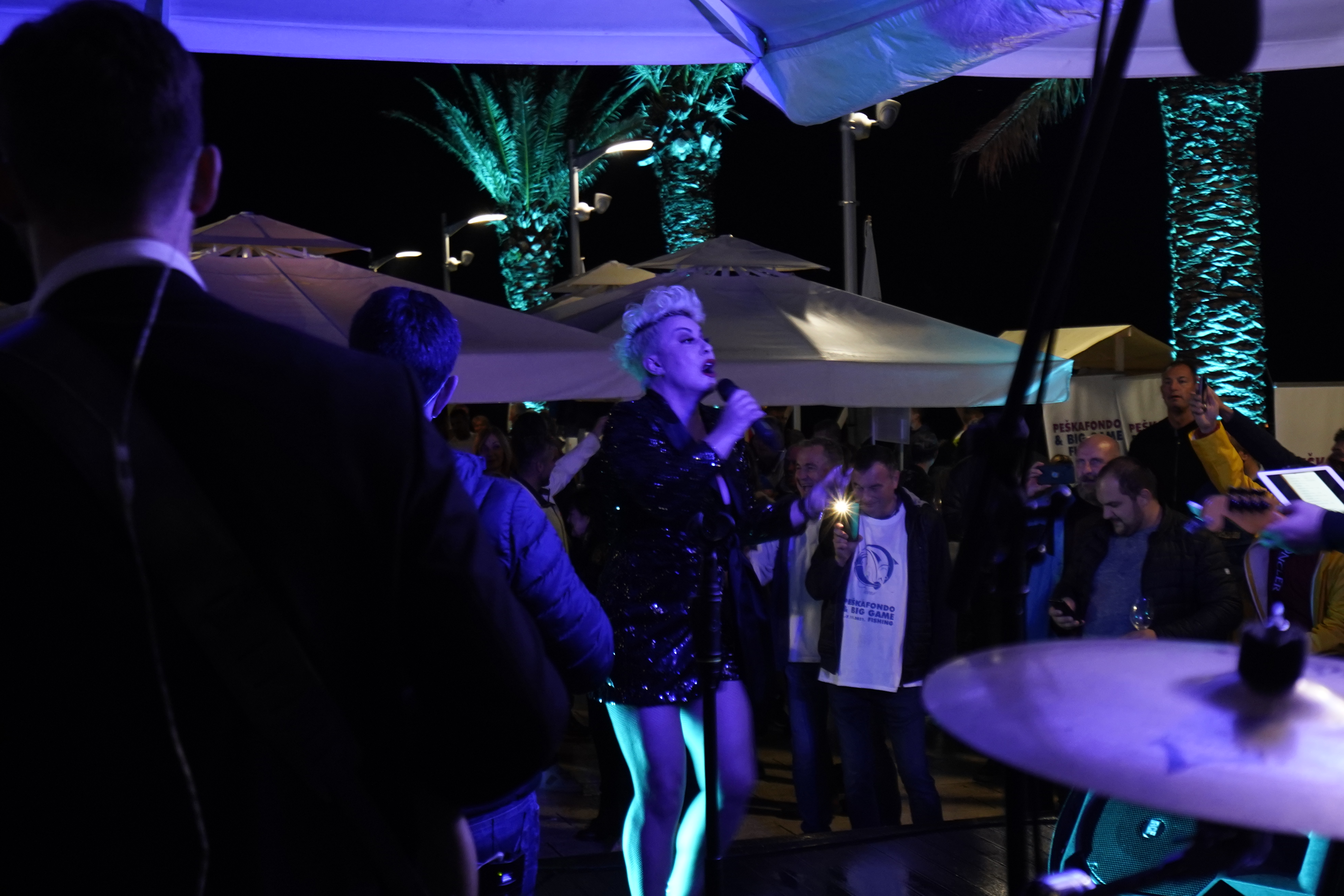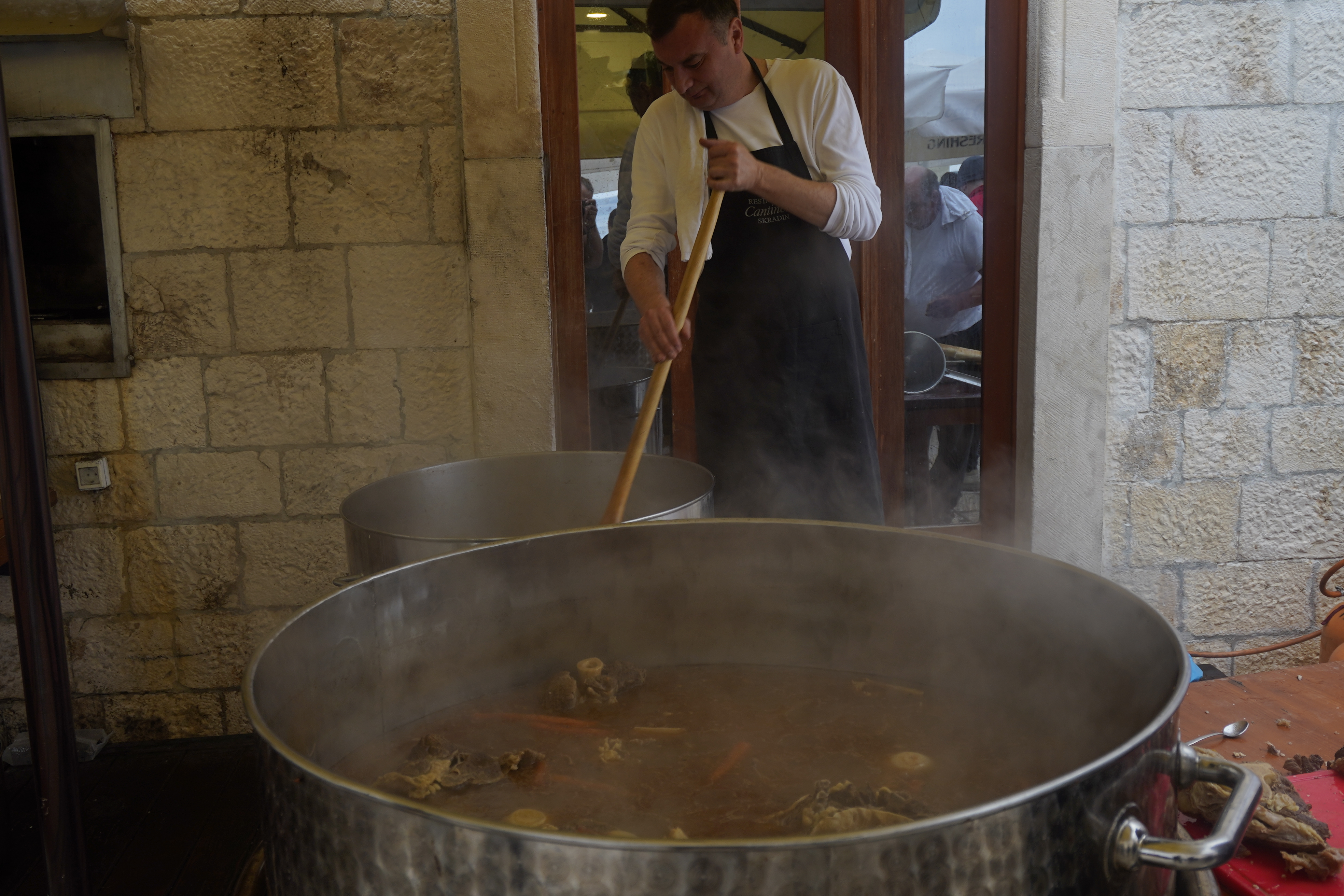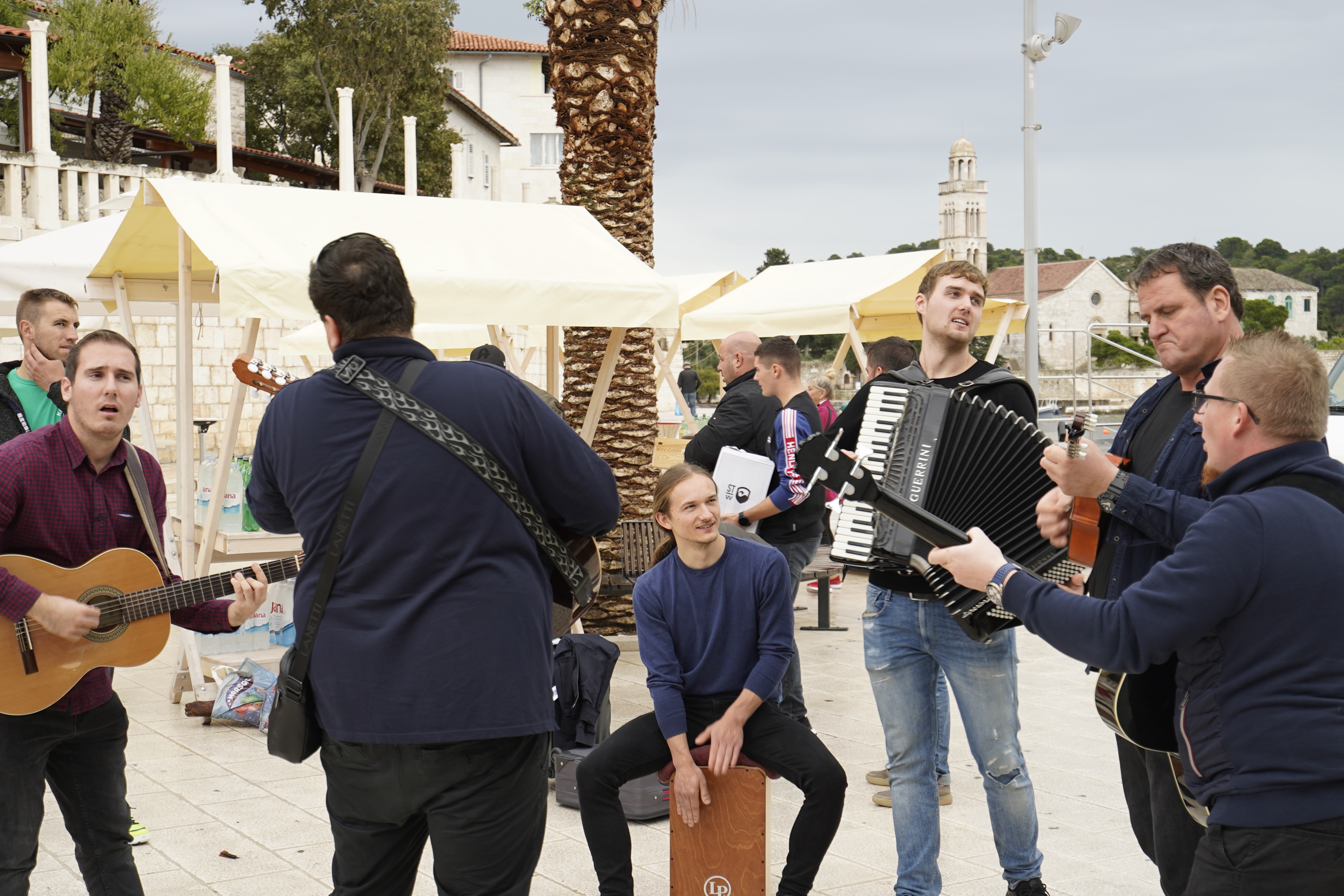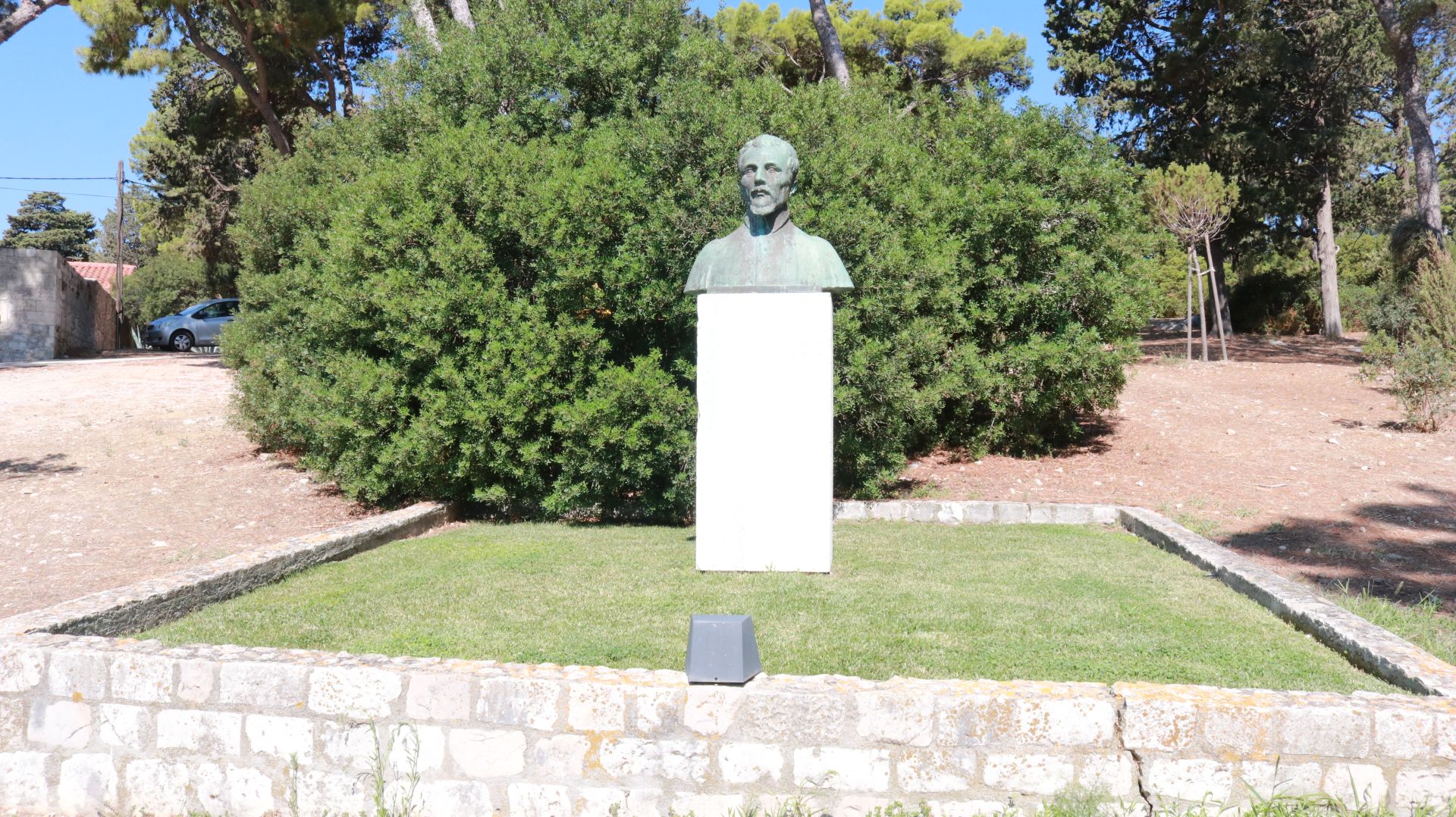Condé Nast Traveler 2022 Readers’ Choice Award: Vote for Palace Elisabeth, Amfora, and Hvar Island!
April 9, 2022 - The island of Hvar was voted the #1 island in Europe last year and has a chance to defend its title in the Condé Nast Traveler 2022 Readers’ Choice Awards! But some of Hvar Island's best hotels are taking the spotlight this year, too.
The Condé Nast Traveler 2022 Readers’ Choice Awards have opened the polls for their annual survey, which includes two famous Hvar hotels Palace Elisabeth and Amfora, as well as the island of Hvar itself in the choice for Best Hotels & Resorts and Islands!
The Reader’s Choice Awards rank the best hotels, resorts, cities, islands, airlines, airports, and cruise lines in the world and it is Condé Nast Traveler’s biggest yearly travel award.
“The last two years changed how and where we all traveled, but also the trips we’re booking now. That makes it more important than ever for you to weigh in on the places getting you excited to travel again—from your all-time favorite hotels, cruises, and beach resorts to the countries, cities, and islands you're escaping to in 2022 and beyond. Plus, we want to hear all about what your last travel year looked like. So please vote, share, and tell us everything," writes Condé Nast Traveler.
Receiving this recognition of excellence is highly valued in the travel industry.
So, how do you vote?
Step 1: Visit https://www.cntraveler.com/rca/vote
Step 2: Log in with your Facebook account or ‘Register’
Step 3: Click on the “Islands” and/ or "Hotels and Resorts" category
Step 4: Search - Hvar / Palace Elisabeth / Amfora / and vote
Share your travel experience by voting in the 2022 Condé Nast Traveler Readers’ Choice Awards by June 30, 2022.
And don't forget...
Sunčani Hvar Hotels Spring Specials are here, with enticing offers at two of its most in-demand hotels - Adriana & Amfora!
Spice up your Easter break with a minimum 2-night stay at Adriana spa hotel, with prices starting from 59 EUR per person and breakfast included! But that's not all. Adriana guests will receive a bottle of house wine and a 10% discount at its restaurants and bars during their stay. This offer is valid for the month of April with a free upgrade upon availability.
And if you can't make it in April but still want to explore the charms of Hvar this preseason?
Amfora resort has also announced a Spring Special during one of the most beautiful periods to visit the island. From 51 EUR per person with breakfast included (and a minimum 2-night stay), guests also receive a bottle of house wine, a 10% discount at its restaurant and bars, and a free upgrade upon availability. This offer, however, is valid from April 20 to June 1, 2022!
For more, check out our travel section.
Why Doesn't Hvar Olive Oil Have the Origin Label Yet?
March 8, 2022 - In recent days it has been said that many islands have already received designations of origin or geographical origin for their olive oils, but Hvar olive oil has not yet. Why? And why is it important to have this label?
Olive oils from Cres, Krka, Korčula, Šolta, and most recently Brač are mentioned, while the people of Hvar are currently proud of their multi-millennium oil production, which has been used as food, medicine, and light on their island for a long time, writes Slobodna Dalmacija.
Today, according to the agricultural advisor mr. sc. Stanislav Štambuk, this island area cultivates more than 250,000 olive trees. Farmers have made good progress in terms of proper implementation of agro-technical measures, fruit picking and processing, and oil storage. There are several modern oil mills, so extra virgin olive oils are most often produced.
This is sufficiently evidenced by the numerous recognitions of Hvar olive growers and oil mills won in the country and abroad (USA, Japan...), it is surprising that an island of less than 300 square kilometers has as many as six protected values on the UNESCO List of Tangible and Intangible Heritage (Faro Choir, agave lace, procession 'Za Krizen', klapa song, Mediterranean food, and the art of drywall construction), but no indication of origin or geographical origin among 33 Croatian agricultural and food products registered with the European Union.
Slobodna Dalmacija decided to check what the problem is, especially because these labels are on the one hand a valorization of achievements so far and on the other an incentive to follow the path of progress and better quality even more decisively.
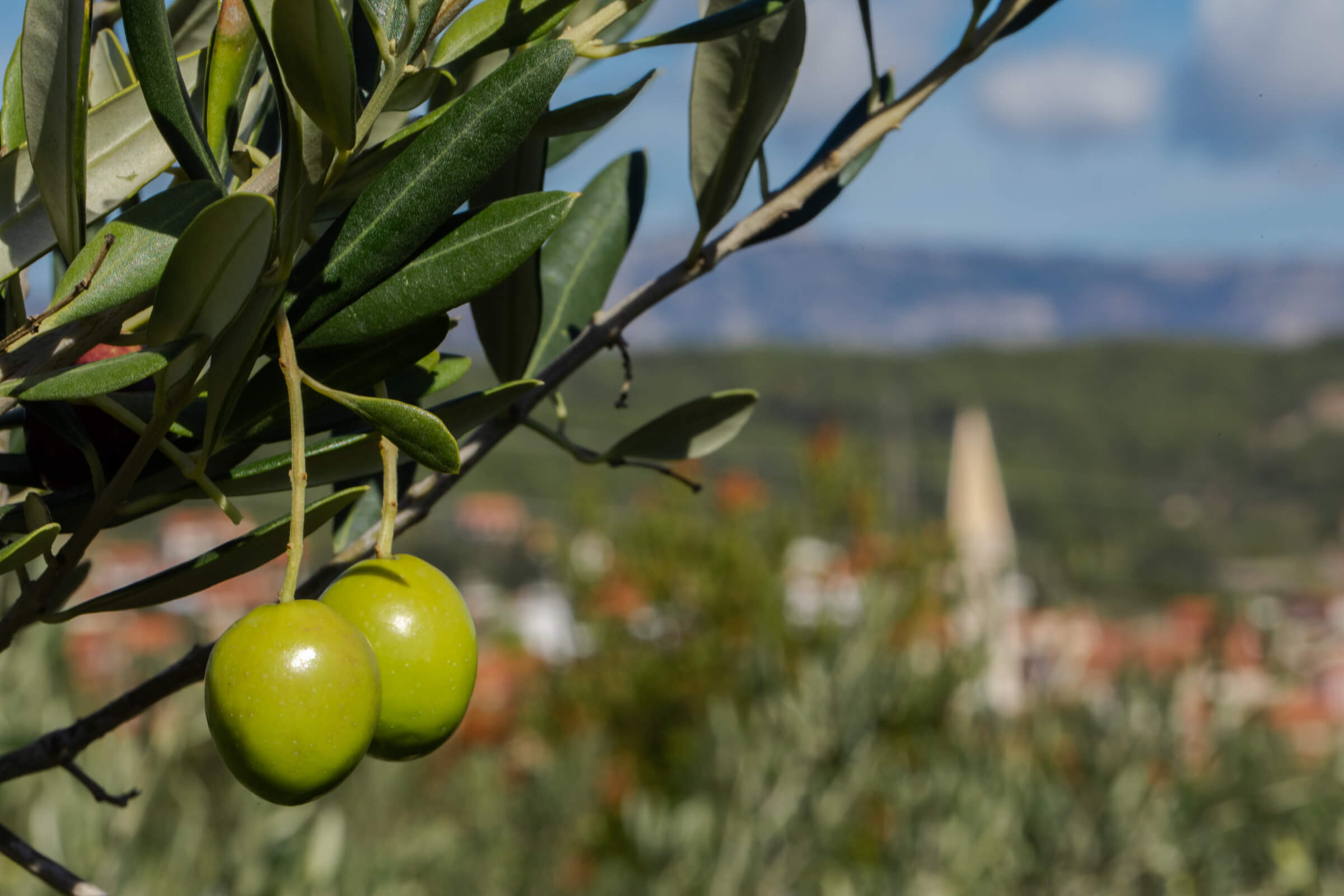
Olives from Hvar (Photo: Mario Romulić)
''There has been talking for a long time on Hvar about initiating this procedure, however, the initiative was somewhat more seriously concretized at the end of 2019 with representatives of the Association of Olive Growers St. Spirijun in Milna. Since then, several enthusiasts have been working continuously to gather the necessary arguments, such as historical evidence, data on varieties, geo-climatic conditions, traditions, processing, use of names and labels, invoices, delivery notes, media articles ..., and when all this is completed we could at least go for a geographical indication because the differences between the designations are small anyway, and the benefits are almost the same'', said prof. dr. sc. Ivica Ljubenkov, an expert who also helped the people of Brač in their candidacy for the origin label.
A tradition dating back to the ancient greeks
One of the problems, as been found out, is that on Hvar, which is famous as the sunniest island (more than 2,700 hours of sunshine a year), there is not a single well-known indigenous olive variety, such as people from Šolta have Levantine, or people from Korčula have Lastovka.
And the candidacy for the label of origin is somehow the easiest to 'wrap in cellophane' of these original varieties, the logic of the European Union is not always in line with the thinking of our people.
Also, it must be added, that despite the declarative desire, the road to acquiring the label is long and difficult, in part due to the low involvement of some olive growers and members of the association.
''We are really proud that in the upper part we have evidence of olive growing and olive oil production from the time of the ancient Greeks. This fact is confirmed by an olive tree from the Kuharača site near Zastražišće. The ancient olive tree is truly a natural rarity and a kind of cultural monument. Evidence of olive processing also exists at the Kupinovik site near the Old Town - Faros, next to the old Roman villa rusticae. There are important artifacts such as two olive presses, a mill with a millstone, several basins for sedimentation, several oysters for storing oil... Numerous remains of architecture testify to multiple alterations, which means that the villa functioned for a longer period of 1 to the 4th century'', says the young, but multi-award-winning olive grower Eva Marija Čurin from Gdynia.

Olives from Hvar (Photo: Mario Romulić)
She is also the secretary of the association, which has more than 150 members and is actively involved in the process of obtaining the label. She adds that the "Days of Olive Oil Days of the Island of Hvar" event in Jelsa is organized every year, with the aim of encouraging olive growers to socialize, have a healthy competitive spirit, educate and, above all, increase the quality of Hvar olive oil.
Therefore, the goal is to contribute to the development of olive growing on the island of Hvar, to gain in importance both locally and internationally.
However, the association will not achieve this without its members, so the event was launched to educate these valuable olive growers about the benefits of the label and to encourage them to be more involved in collecting materials needed to obtain it.
''If we recapitulate everything that Professor Ljubenkov and our Eva Marija told us, I would like to tell the membership that, in addition to the objective benefits we would get from labels, they also protect the consumer himself, as the end-user of Hvar olive oil. The labels certainly bring protection against unauthorized use and damage to the reputation of oil that would be produced on Hvar according to pre-established rules. In this way, the consumer would have a guarantee that it is an oil that is recognized and protected specialty of the area from which it originates, and we are aware of the quality we have can only say that this label will be only the first step in further promotion of Hvar olive oil, the island where we live and produce'', concluded Đorđan Gurdulić, president of the Association of Olive Growers "St. Špirijun" from Hvar.
When it comes to olive oil, Croatia is one of the leading countries in the industry. From Istria to Dalmatia, you can find all the information you need to know about the origins, processes, and where to buy Croatian and Hvar olive oil on the Total Croatia page, now in your language!
For more on Croatian products, producers, companies and exports, make sure to check out Made in Croatia.
Sunčani Hvar Hotels Spring Specials: Preseason Deals at Adriana & Amfora!
March 4, 2022 - Because you don't have to wait until the summer to visit Croatia's sunniest island. Sunčani Hvar Hotels Spring Specials are here!
It's no surprise that the glamourous Hvar town is one of the busiest summer hotspots in Croatia. Still, many may not know that the popular town is also a gem in the offseason months - and you get to experience it without the peak season crowds.
As a way to tempt travelers to Croatia's sunniest island in the calm before the tourism storm, Sunčani Hvar Hotels Spring Specials are here, with enticing offers at two of its most in-demand hotels - Adriana & Amfora!
Namely, spice up your Easter break with a minimum 2-night stay at Adriana spa hotel, with prices starting from 59 EUR per person and breakfast included! But that's not all. Adriana guests will receive a bottle of house wine and a 10% discount at its restaurants and bars during their stay. This offer is valid for the month of April with a free upgrade upon availability.
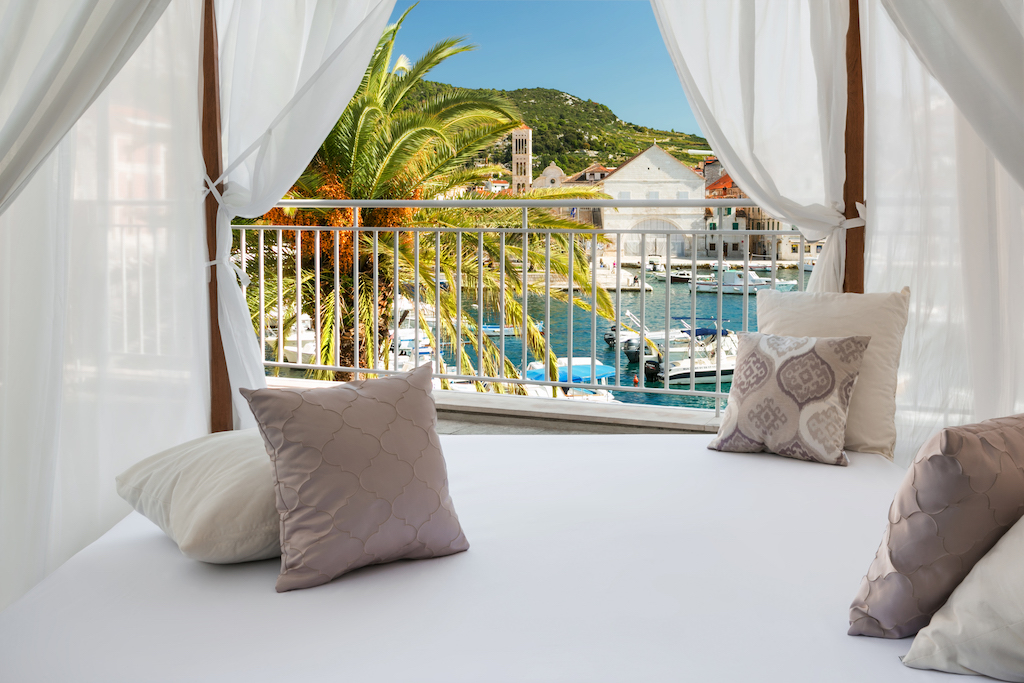
And if you can't make it in April but still want to explore the charms of Hvar this preseason?
Amfora resort has also announced a Spring Special during one of the most beautiful periods to visit the island. From 51 EUR per person with breakfast included (and a minimum 2-night stay), guests also receive a bottle of house wine, a 10% discount at its restaurant and bars, and a free upgrade upon availability. This offer, however, is valid from April 20 to June 1, 2022!
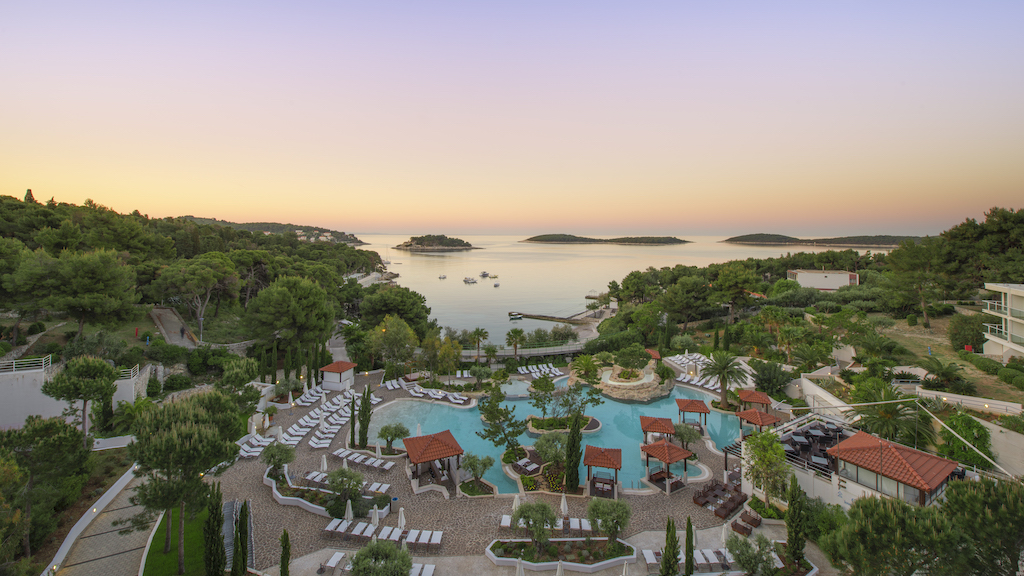
And should you need another reason to visit Hvar?
The island Hvar was voted the #1 island in Europe according to Condé Nast Readers’ Choice Awards, with readers naming its abundant nature, culture, and rich history as to why you should visit.
“With warm summers and mild winters, the island of Hvar is the sunniest spot in Croatia—there are over 2,800 hours of sunshine annually. It may be known for its beaches and turquoise water, but there’s another side to this resort island. From the town of Hvar on the island’s southern shore, make the slow, uphill climb to Tvrđava Fortica, a 13th-century fortress with the best views on the island. Pro tip: To see Hvar’s spectacular fields of lavender in full bloom, visit in early summer. The harvest takes place in late July, but you can buy all sorts of scented souvenirs in the local markets year-round,” writes Condé Nast Traveler.
Need we say more?
For more on travel in Croatia, follow TCN's dedicated page.
Jelsa Becomes the First International Dark Sky Community in Southern Europe
February 28th, 2022 - With its dark night sky now officially certified, the town on Hvar island is set to become a notable astrotourism destination
We recently reported that considerable efforts were being made on Hvar island to decrease light pollution, as part of Jelsa Municipality’s bid to become an International Dark Sky Community.
The International Dark-Sky Association (IDA) has now granted the coveted title to Jelsa, making it the first International Dark Sky Community in Croatia and southern Europe. Jelsa is also the 37th local self-government unit in the world to bear the prestigious title, reports Morski.hr.
The International Dark Sky Community is a title given to local communities that have shown outstanding commitment to dark sky conservation through the implementation of lighting policies, education on dark sky conservation, and citizen support for the initiative.
‘Jelsa Municipality has set a high standard that should be followed by other local governments in your country and this region of the world. We’re honoured to bring attention to Jelsa as a prominent leader in setting an example of how the proper use of lighting benefits people's well-being, as well as the night environment in our communities and beyond’, said the International Night Sky Protection Programme Director Ashley Wilson.
The process of declaring Jelsa an International Dark Sky Community was set in motion by the Jelsa Tourist Board Director Marija Marjan, and the procedure and activities related to the bid were managed by the Croatian Astronomical Union. In the past two years, the municipality has swapped 82% of its unprotected public lighting for fully protected 3000K lighting in accordance with IDA requirements.
The project was implemented over the course of a year, and it involved numerous activities ranging from public telescope observations, lectures, exhibitions, events and astronomy schools for elementary school students to the development of a five-year work plan and environmental lighting guidelines.
Jelsa’s bid was submitted in December last year, and once the additional conditions required by the IDA were fulfilled, the municipality was granted the title of an International Dark Sky Community.
The International Dark Sky Places is an initiative launched in 2001 as a non-regulatory and voluntary programme meant to encourage communities, parks and protected areas around the world to preserve and protect the natural night sky through the adoption of effective lighting policies, environmentally responsible outdoor lighting, and education.
‘Careless use of artificial lighting can disrupt entire ecosystems, have an adverse effect on human health, unnecessarily waste money and energy, considerably contribute to climate change, and obstruct our view and connection to the universe we live in. Jelsa joins the international community of more than 195 protected areas that have made exceptional contributions to the protection of the dark sky from light pollution, and is well on its way to becoming the first serious destination for astrotourism in Croatia’, stated Jelsa Tourist Board.
Places that are known for dark night skies, especially those destinations that have received official certification in this regard, are extremely rare and attract amateur astronomers from all over the world. Citizens of countries that are struggling with light pollution, such as Germany, France, Spain and Italy, constantly seek out locations that will allow them to enjoy the dark night skies.
A Croatian island now joins the list of such locations, with Jelsa officially certified as an ideal location for night sky watching. As such, it will surely attract a new group of tourists, who will no longer have to travel to the Canary Islands to gaze at the night sky.
VIDEO: Classic Island Vibes and Vistas of Spectacular Summertime on Hvar
November 25, 2021 – From the epic medieval harbour of Vrboska and the buzz of Hvar town to the historic streets of Stari Grad and 250 kilometres of brilliant beaches, this new footage of summertime on Hvar is making us yearn for next season.
 © Goran Šafarek
© Goran Šafarek
Hvar Town is overflowing with life in summer. By day, families wander by the waterside or between restaurants in the old town. By night, bars and discos are vibrant and full. In Stari Grad, a constant stream of excited new visitors arriving by boat. Such scenes tell of the popularity of summertime on Hvar. Arguably, this is Croatia's most well-known island for holidaymakers.
 © Goran Šafarek
© Goran Šafarek
But, away from the throngs of people in Hvar Town and Stari Grad, there's a distinctly different side to this island. Famously, Stari Grad Plain (Starogradsko polje) on the interior looks much the same now as it did over 2000 years ago. That's how long grapes and olives have been cultivated here. Pretty rows of vines and fields of olive trees or lavender colour the landscape all over Hvar. Passing by these agricultural endeavours gives a better reminder of just how much room there is for everyone on Hvar.
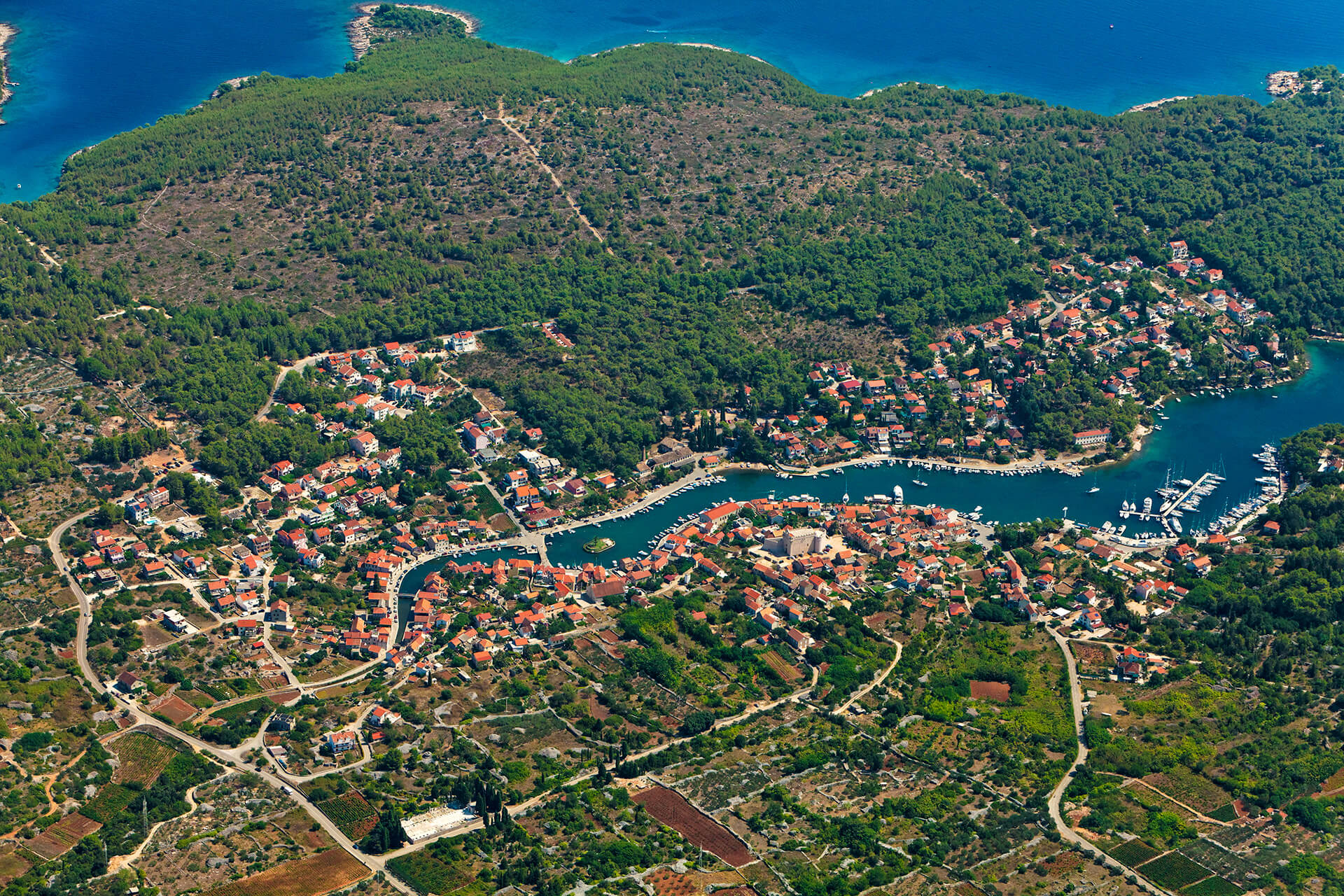 As shown above, the long, ancient harbour at Vrboska © Goran Šafarek
As shown above, the long, ancient harbour at Vrboska © Goran Šafarek
With 250 kilometres of its own coastline, Hvar is not short of beaches. People love swimming in the island's crystal clear waters. Sailors love them too. In the ancient harbour of Vrboska, there's an altogether different feeling to arrivals by boat. Here, elegant yachts gracefully cruise into the long, thin harbour. They find temporary homes near small, traditional fishing boats. Inside, summertime sailors may have chosen this beautiful part of the island because of its famous restaurants. After the gastronomic joy of lunch, maybe they'll wander the historic promenade or visit one of the famous winemakers near here.
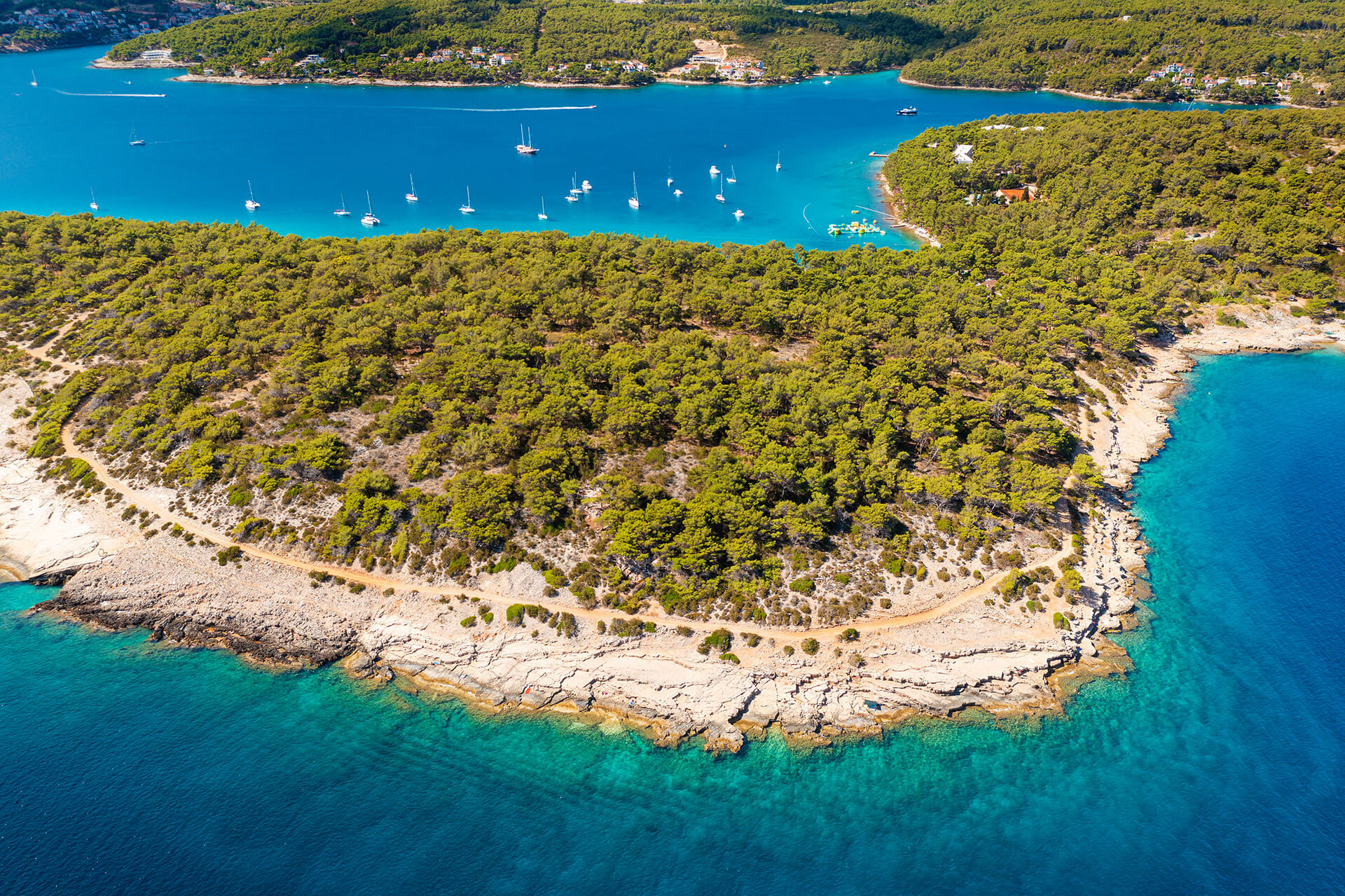 In the background, sailors into Vrboska © Goran Šafarek
In the background, sailors into Vrboska © Goran Šafarek
All these different aspects of summertime on Hvar and more have been captured in an all-new video made by Goran Šafarek. Goran, who is an independent biologist, publicist, photographer and filmmaker, was on the Adriatic working in summer 2021. His assignments included film work commissioned by Croatian National Parks. But, he took advantage of being on the coast and made time between assignments for a family sailing holiday. He visited Korčula island and Hvar island, using the opportunity to make new videos of each.
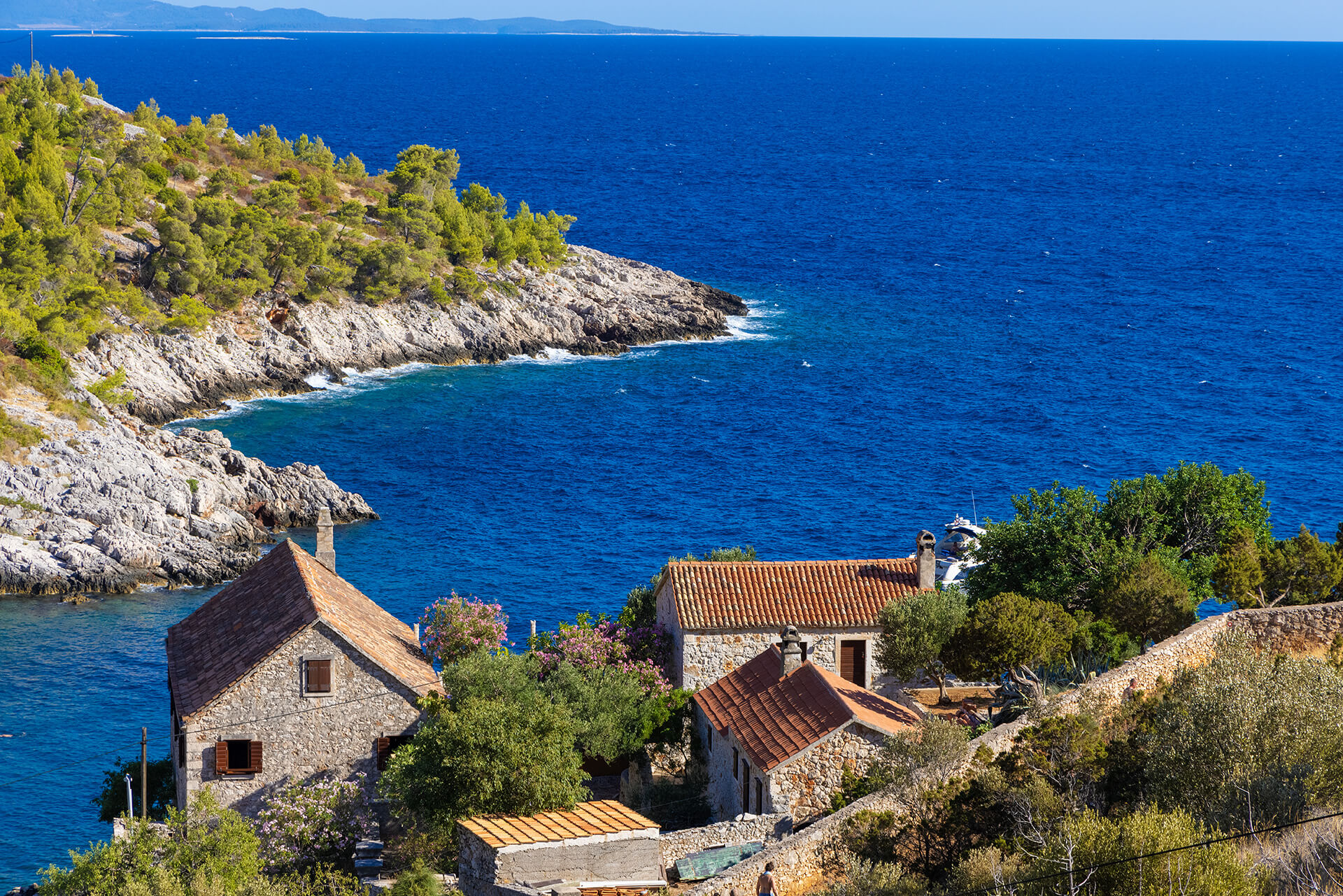 © Goran Šafarek
© Goran Šafarek
Total Croatia News has already published Goran's new video of Korčula, which you can watch here. This new one of Hvar has us pining for summer and making plans for next.
For more info about Hvar island, look here. And for the latest news from Hvar, bookmark Total Croatia News pages here
Team 45 Degrees Sailing Takes on Peškafondo 2021
Tuesday, November 9, 2021 - After a COVID-19 instigated break last year, the much-acclaimed Peškafondo 2021 was back to celebrate its 10th year as an international fishing and tourism event.
365 GARIFUL HVAR
Organised by the “365 Gariful Hvar” association, 48 teams entered and competed in the waters of Hvar. Each team was comprised of four members, and registration was 500 kuna for each member. There was also an ongoing opportunity to donate in order to partake of the non-fishing festivities, money that will go to a local charity as chosen by the “365 Gariful Hvar” association. Read more here where Ivan Gospodnetić, owner of the much famed Gariful restaurant, talks to Paul Bradbury about why he started this festival in the first place and how he has watched it grow and evolve over the years.
KICK START CELEBRATIONS
Not having any idea what to expect, we were invited by Ivan via Paul to join in on the festivities and boarded the catamaran to Hvar town on Friday. The program officially started at 1 pm so we decided to catch the 10 am ferry to give us plenty of time to get settled before festivities kicked off. Little did we realise that the Šibenik Klapa group were on the same ferry, and they started things off early, pulling out their instruments and playing for all of us on the ferry. What a great way to kick off the weekend!
THE SQUID GAMES BEGIN
As the ferry pulled alongside the Hvar Riva, they continued to play as they disembarked the boat, being welcomed warmly by everyone already gathered and set up outside Gariful restaurant. Peškafondo and Big Game Fishing 2021 was off to a great start. Teams began to gather at the tables set up outside the restaurant, everyone was registering, getting their t-shirts, having a warm hearty lunch. The trumpet signaled at 3 pm and was the sign for all of the fishing boats and their teams to head out in search of the desired squid. They would disperse in the waters around Hvar and Pakleni islands and put their lines down hoping for a bountiful catch.
DAY ONE CELEBRATIONS
At 8 pm the boats returned amidst live music and the buzz of dinner beginning, and the catches were weighed and measured in full sight of everyone in attendance. Most teams were pretty successful and it was a great atmosphere for everyone to warm up and wind down after the hours spent out on the boat. The wine and beer were flowing, and the celebrations continued into the night.
DAY TWO BEGINS
The next morning at about 8 am, the big game fishing boats departed the Hvar Riva and spent all day out fishing, in pursuit of the elusive big catch! After another very colourful departure of the squid fishers at 3 pm again, they spent another afternoon out to catch as many squids as they could find. It was a much harder day out, as rain impeded the time out for many, especially those in boats without shelter. Fishing is certainly a sport that is at the mercy of the weather
RAIN, RAIN, RAIN
The rain continued as the days' catches were weighed and measured, and it certainly did not dampen the enthusiasm of the crowd that came out to support their friends and family members. A very wet award ceremony ensued, and it was great to see mixed teams, kids, and families having participated, as everyone came up to receive their prize and/or trophy.
And then the final party began. With the help of more delicious food, drinks, and live music, the vibrant and dynamic festivities continued into the night. An apt way to end the adult portion of a fantastic weekend celebrating the much-esteemed squid, in the quintessentially Dalmatian manner of celebration.
SHOUT OUTS FOR THIS EVENT
We had a couple of take-aways and shoutouts from this event.
AMAZING FOOD
Oh my goodness the food. Warming, fill-your-boots, hearty, nourishing food for a large crowd of people is one thing that Croatians really excel at. And all teams gathered by 365 Gariful Hvar Association totally went above and beyond to ensure that not only did the food taste good, it tasted amazing and it also showcased specific Croatian traditional dishes from a couple of different regions. Like arambaši from Sinj and the famous Skradin risotto! As well as demonstrating how heart-warming and relevant traditional cuisine still is in the setting of modern events and festivities.
Huge vats of slow-cooked meats and seafood wafted incredible smells that led you down the Riva. All chefs were engaging and got involved in the fun, all while they were cooking and serving. They took time out to talk to us and show us what they were cooking. They helped to make the atmosphere bright and warm, despite the persistent rain!
LACK OF RUBBISH
We were also very impressed by the lack of rubbish and the major lack of single-use plastic. Serving plates and utensils were paper and wood, cups were washable and reusable. And the staff working the event were fast, efficient and effective. There was no chance for any rubbish to blow onto the ground or into the sea because it was cleared away so fast. Full carafes of wine and bottles of sparkling water were brought to your table before you even realised that the existing bottles were running low. It was an incredibly clean, well-organised environment, which is an awesome achievement in normal circumstances and especially so given the incessant wet weather.
HIGH ENERGY ATMOSPHERE
The music was great. Even though it was all in Croatian, based on the enthusiasm from everyone else around us, they were clearly playing popular and classic Croatian songs. And we loved the variety. From the homespun acoustic style of the Šibenik Klapa to the powerful seasoned performance of Indira Vladić (Levak), it was all upbeat, enormously engaging, and great fun to be in the midst of.
The atmosphere was just great. The various elements, the music, the food, the staff, the logistics going on throughout the weekend, they all added up to a really enjoyable, wholesome event.
ALL-INCLUSIVE
We also loved the fact that you don’t have to be out on a fishing boat to enjoy this event. In addition to the 500 kuna fee to register as a member of a team on a fishing boat, you could also donate and participate in the on-land parts of the event. Which were aplenty! Everyone felt included no matter your age, nationality, or fishing and squid catching skills, or total lack of! This was especially true on Sunday, which was Kids Day. Complete with bouncy castles, balloons, games, and activities, thank goodness the sun came out to shine down upon what felt like the whole of Hvar and their kids! The sound of delight, laughter, and joy filled the main square of Hvar.
Given that we were non-Croatian-speaking foreigners who knew very little about the event and pretty much knew no one at this event, we felt very welcome and included. We had the opportunity to meet some of the fishermen, many of whom also work in the marine tourism industry. We enjoyed chatting with the chefs as they described what they were cooking for us. As well as making some awesome connections with individuals from other areas of Croatia, like Monika from Sinj (see her article here).
All in all, this was an event that we have heard nothing about during our five-year stay in Croatia. And now we have been, we can’t stop talking about it!
I think Ivan from Restaurant Gariful put it well when he said “I can't describe the happiness I feel knowing Peškafondo is no longer just about Hvar, it's becoming something that can be about all of Croatia.”
If you’re looking for an “authentic” experience in 2022 or beyond, this is one event you really need to check out. We highly recommend this event to any foreigners and Digital Nomads who find themselves in Croatia once the summer crowds have gone and are looking for real local events to take part in. This is all of those things in spades.
If you have questions on anything sailing in Croatia, feel free to ask below in the comments or check out Total Croatia, Sailing in Croatia: Your One-Stop-Shop for everything sailing.
If you’re looking for a little more history around this event read Paul Bradbury’s interview with Ivan ‘Gariful’ Gospodnetić here: Celebrating 10 year of Peškafondo.
For more on the programme and reflections on the last ten years of Peskafondo, read Squid Games on Hvar.
Great Archaeological Finds Discovered in a Cave on Hvar
ZAGREB, 6 Nov 2021 - The cave called "Babina Špilja" on the Adriatic island of Hvar was explored by archaeologists this summer and autumn when they found ceramic items and animal bones dating back to the early Neolithic period and a pebble with natural markings, which appears to have originated from the Mesolithic.
The discoveries are currently in Oxford for radiocarbon dating, archaeologist Marcel Burić has told Hina.
The results of that analysis will be completed in January 2022, and they will indicate whether or not people had existed on this Croatian island also before the early Neolithic.
The exploration was triggered off by the results of the doctoral thesis of researcher Alen Miletić who has studied the topography of prehistoric sites on the western side of Hvar.
Babina Špilja is at an altitude of 200 metres.
Burić said that researchers of Columbia University in the City of New York and of La Sapienza in Rome are included in the project of exploration of this site.
For more, make sure to check out our dedicated lifestyle section.
Hvar Town 2021 Photo Essay: Warm August Morning Moments
August 17, 2021 - They say that a picture says a thousand words... TCN reporter Ivor Kruljac teamed up with photographer Nina Lelas to explore the once-again bustling Hvar town center in August. Check out our Hvar Town 2021 photo essay to see for yourself!
It was August 12 and the morning was brutally hot. The world-renowned sunny days on Hvar showed their dark side as I sweat profusely, looking as if someone threw a bucket of water on me.
Leaving my cool room at Pharos for a photo essay on Hvar in the morning felt like a suicide mission. But, one that would be quickly over as I expected nobody would be crazy enough to hang around the town's centre. I figured they would either be at the beach or at the pool and wait for the sun to go down to maybe take a stroll and grab a bite to eat for dinner in one of Hvar's excellent restaurants.
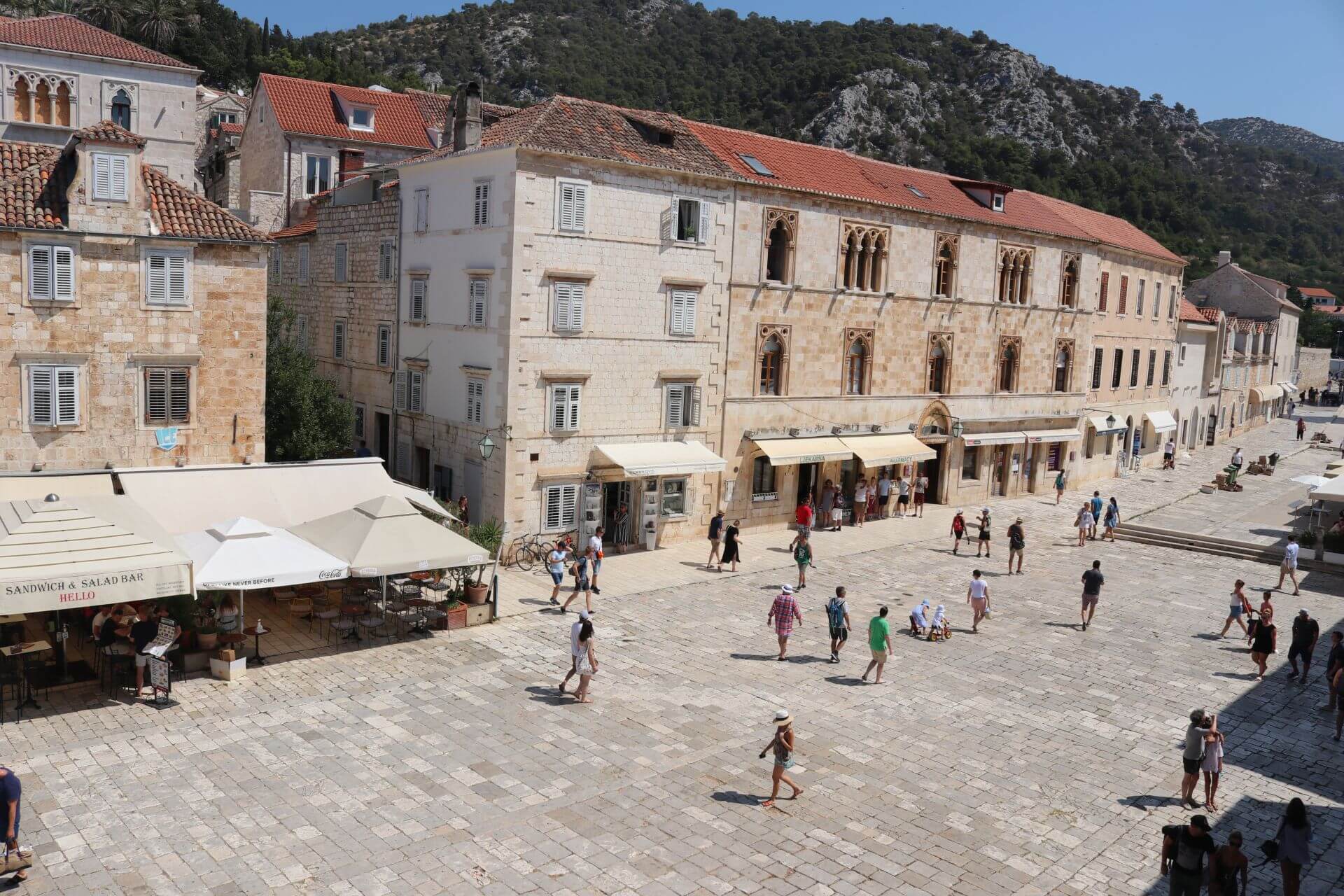
People resisting sun © Nina Lelas
But to my surprise, the town was packed with people. Every cafe seat was completely taken and the main square saw people walking around to see the town. From Hvar's churches, museums, city walls, historical sites, and waterfront promenade with lovely yachts that move your imagination to daydream about a different kind of life – it is a perfect postcard that triggers people's curiosity. Surprisingly enough, the narrow streets next to the main square, which provide much more shade and have their own romantic side, are mostly empty. The few people we came across were actually moving from these refreshing pockets towards the main square. Perhaps, because so many apartments are packed in those streets, they are just not as attractive as many reside there due to accommodation. Take a look at a typical August morning of Hvar and start planning for next season.
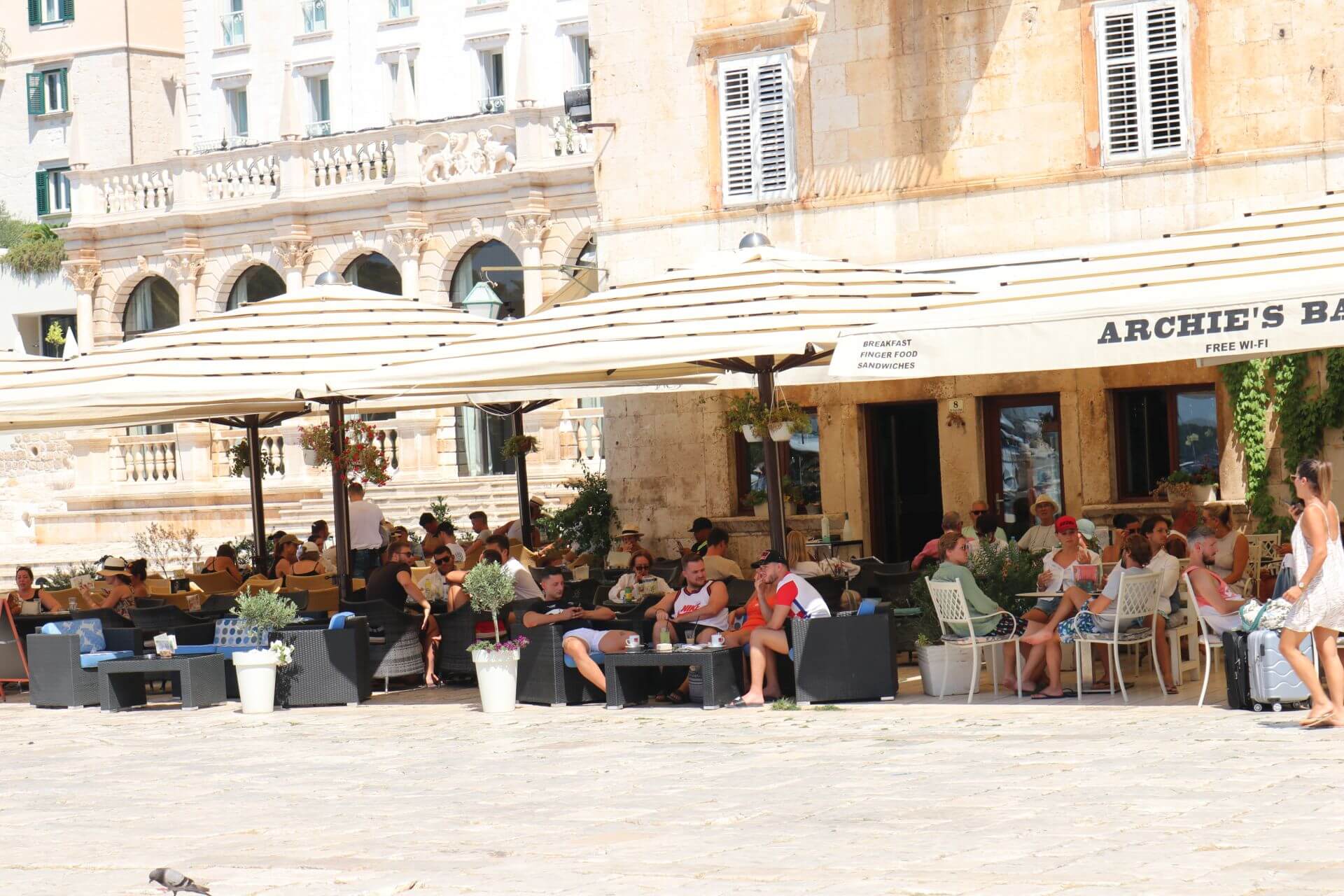
Enjoying coffee and drinks © Nina Lelas
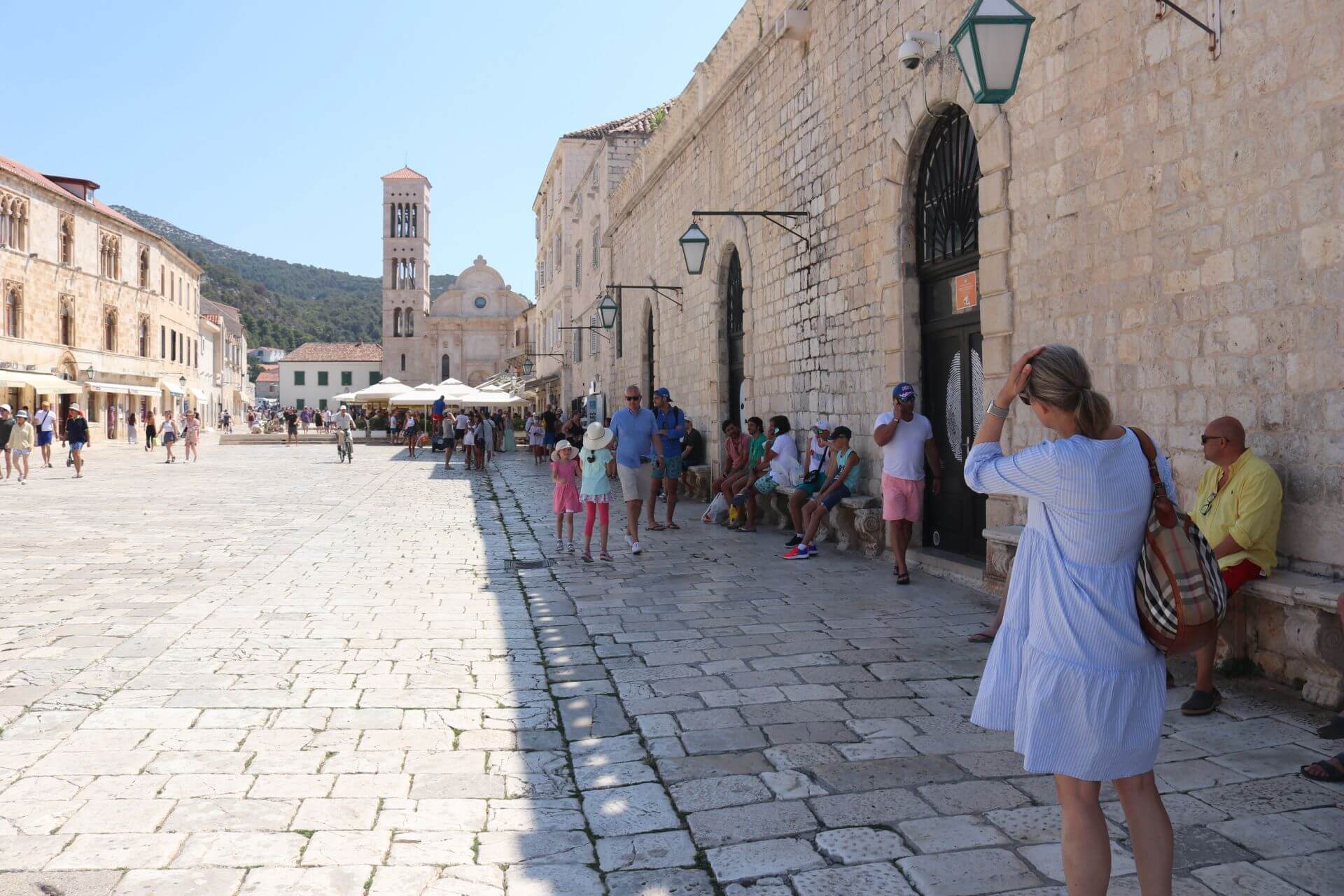
Every bit of shade welcome © Nina Lelas
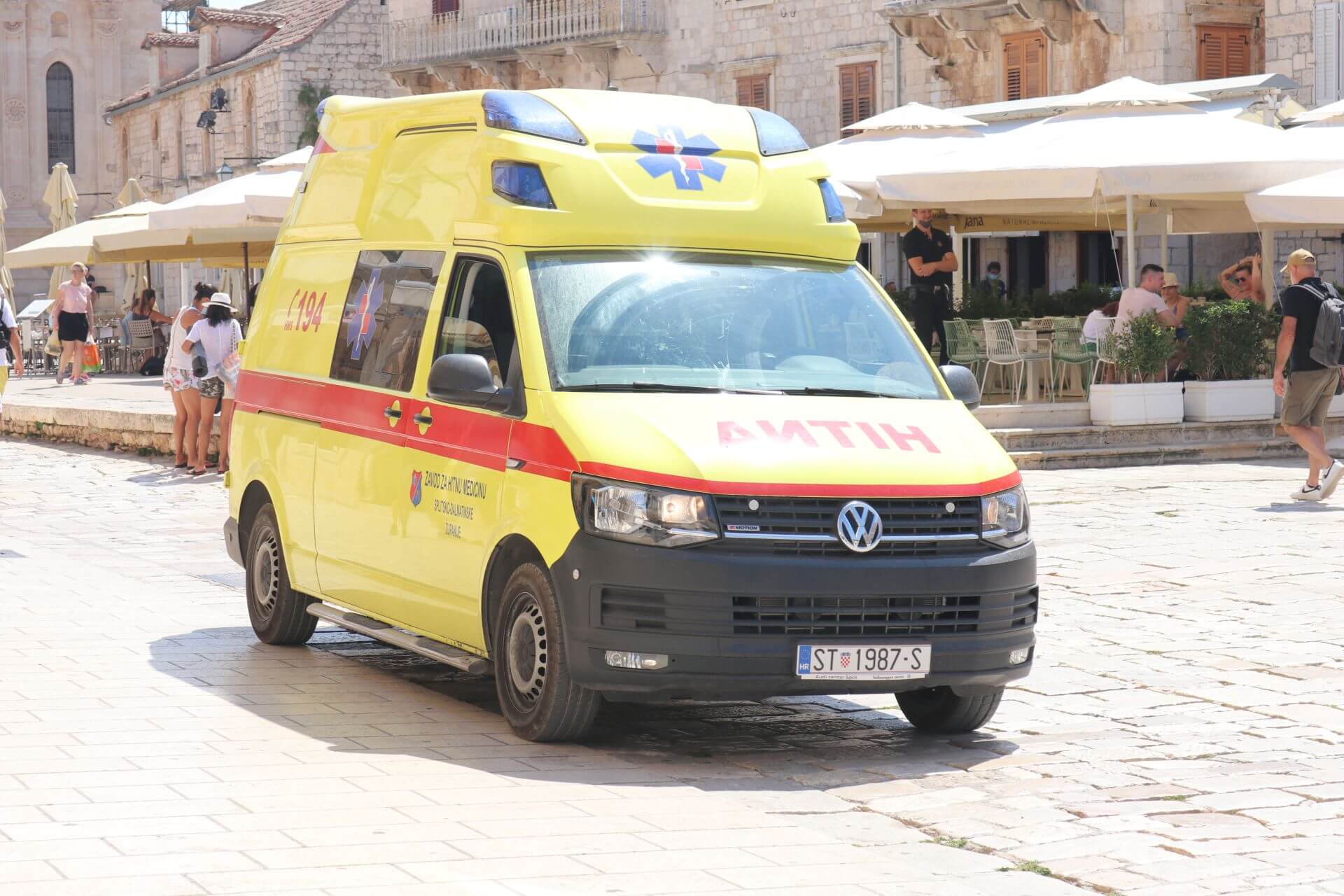
Apart from joy, Hvar can provide healthcare if needed too © Nina Lelas
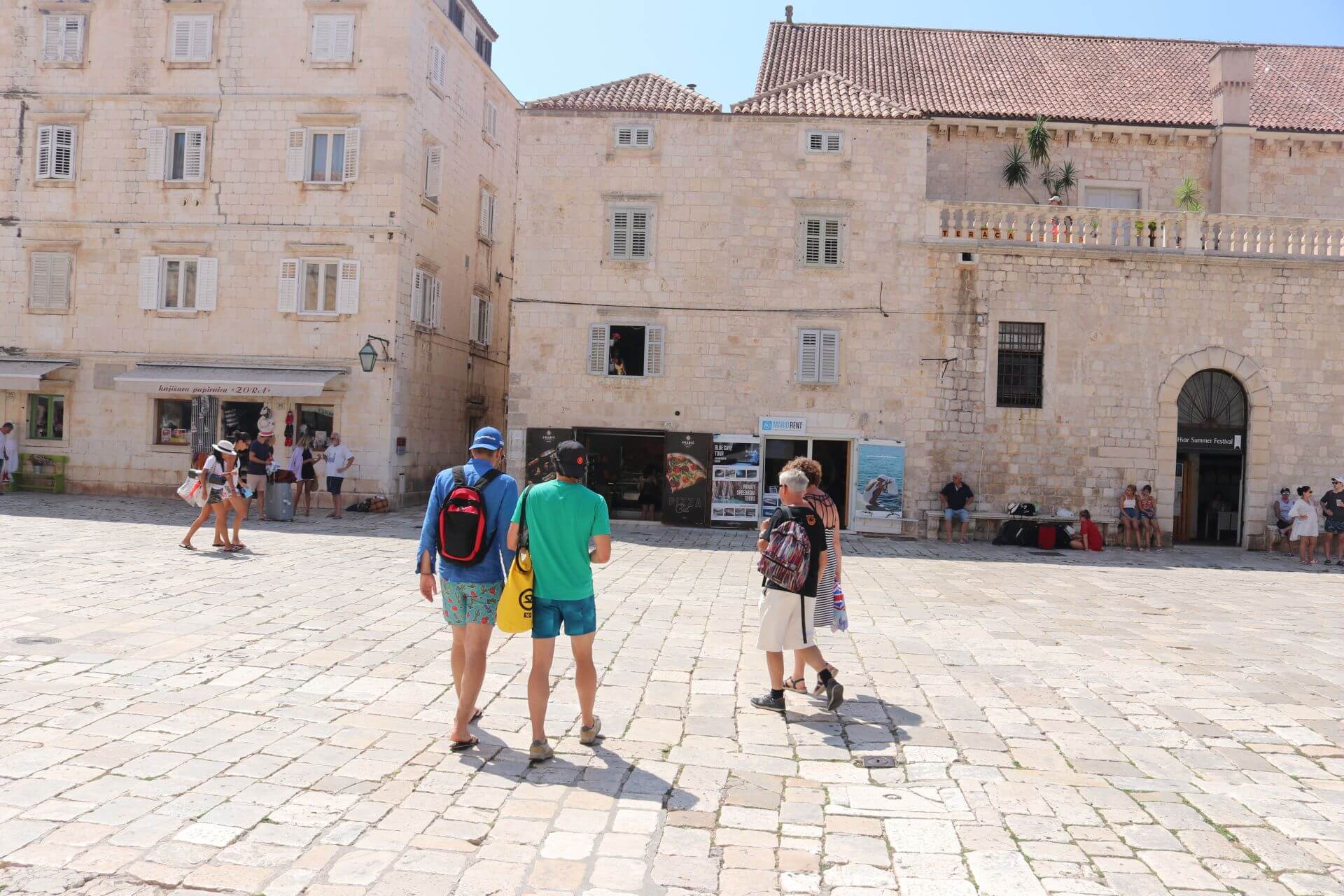
The main square beauty attracts people from every direction © Nina Lelas
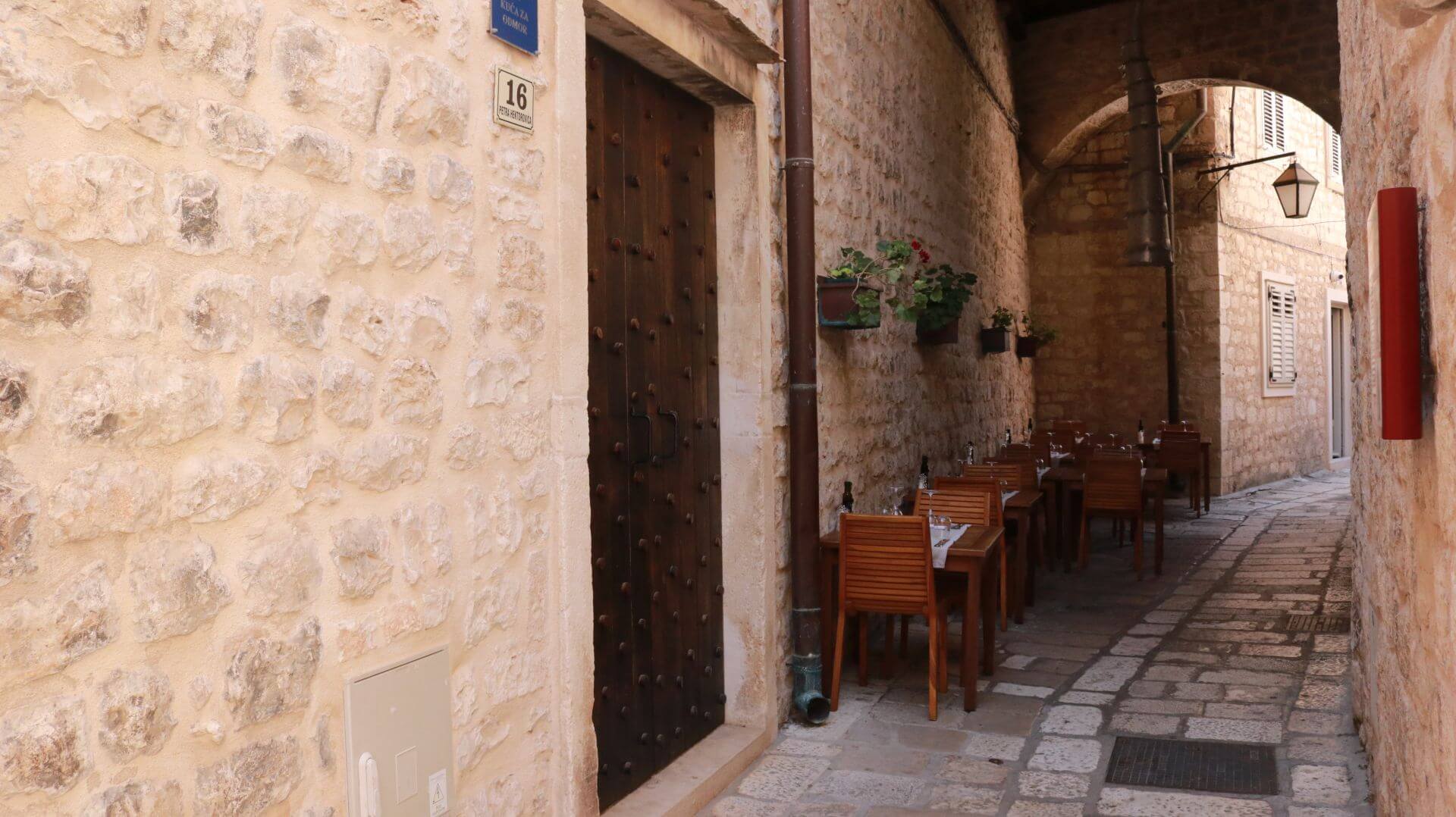
Lovely side streets of Hvar town © Nina Lelas
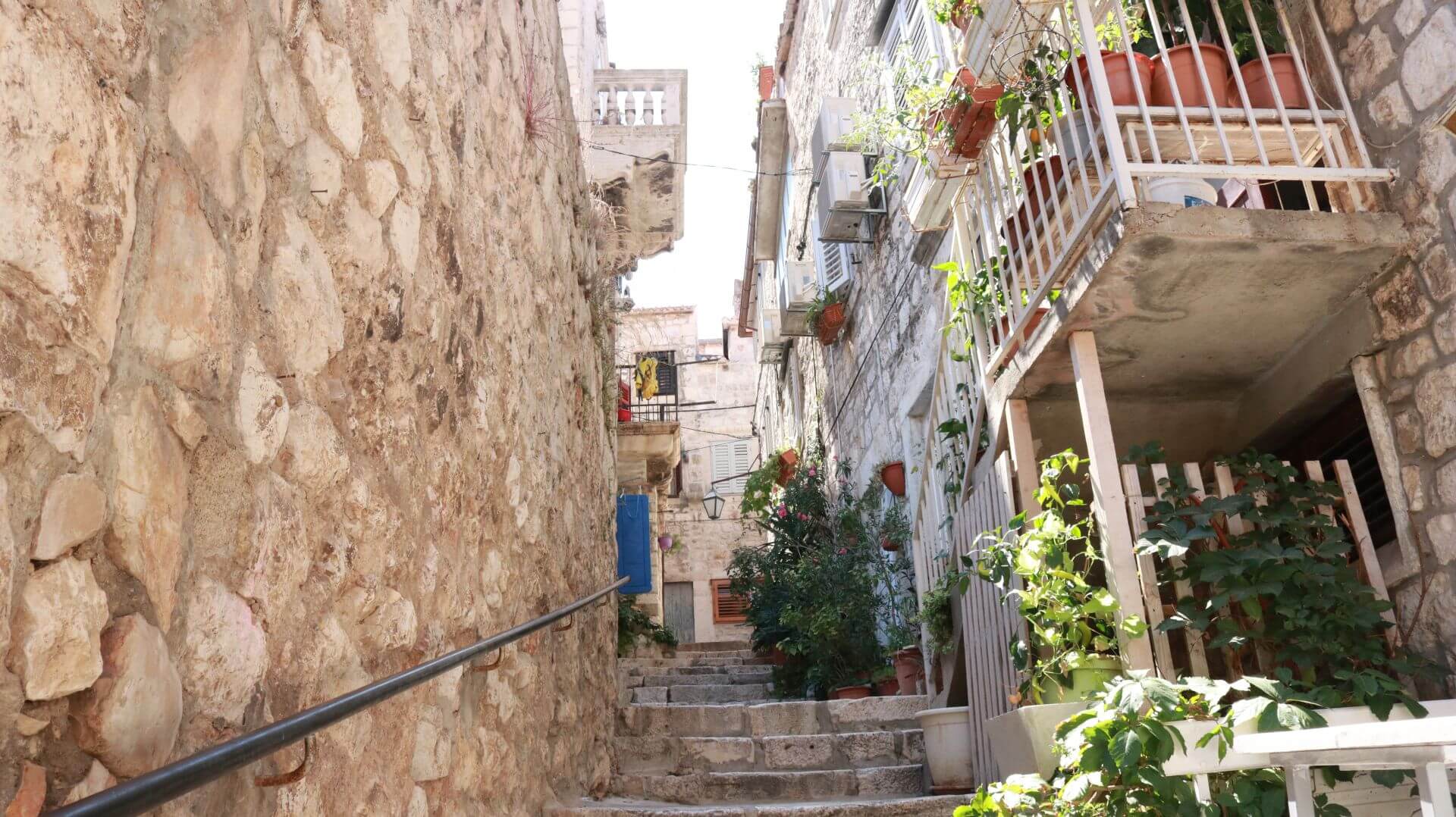
Shade and vegetation of chilled side streets © Nina Lelas
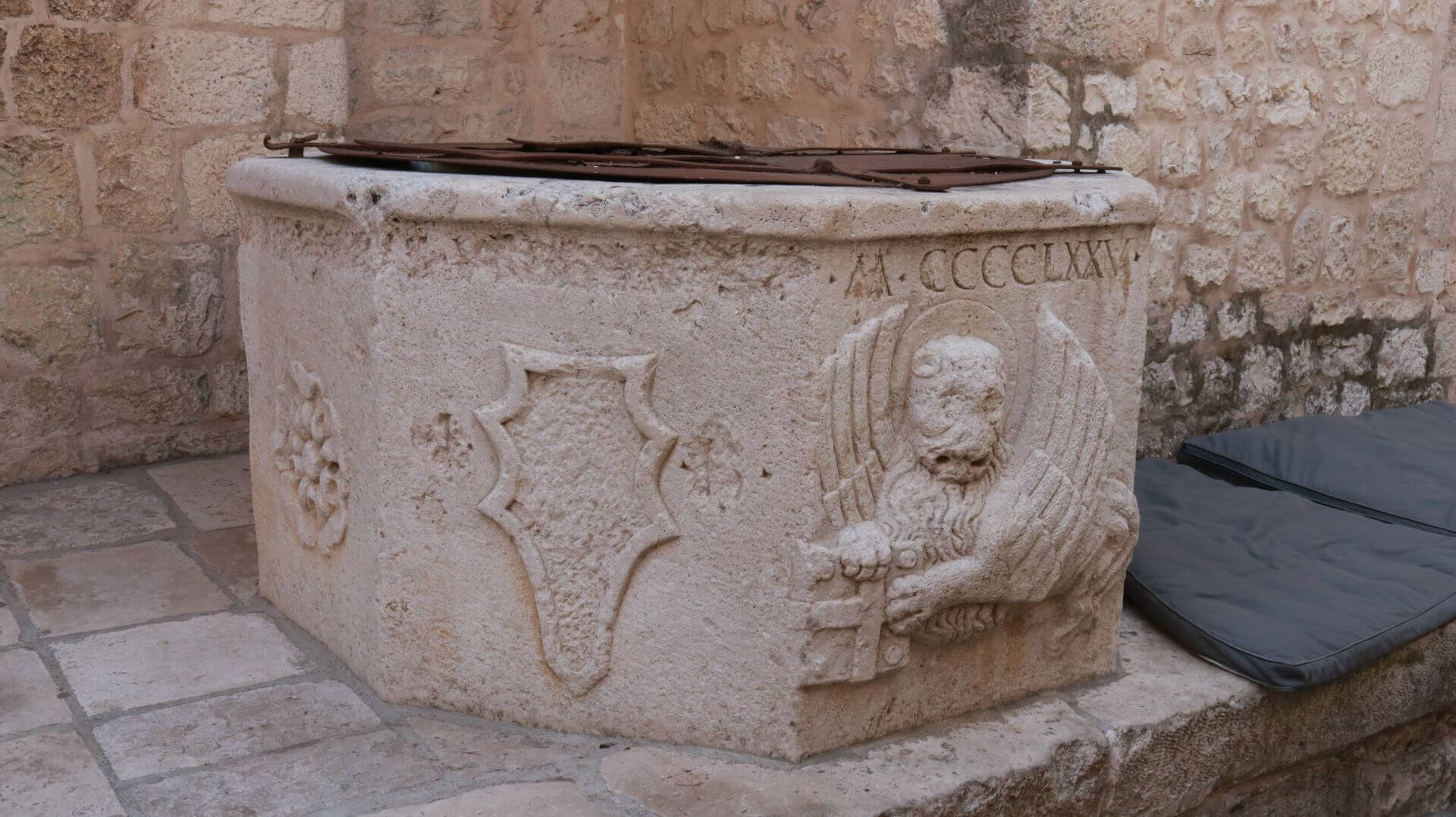
Admiring details on every corner © Nina Lelas
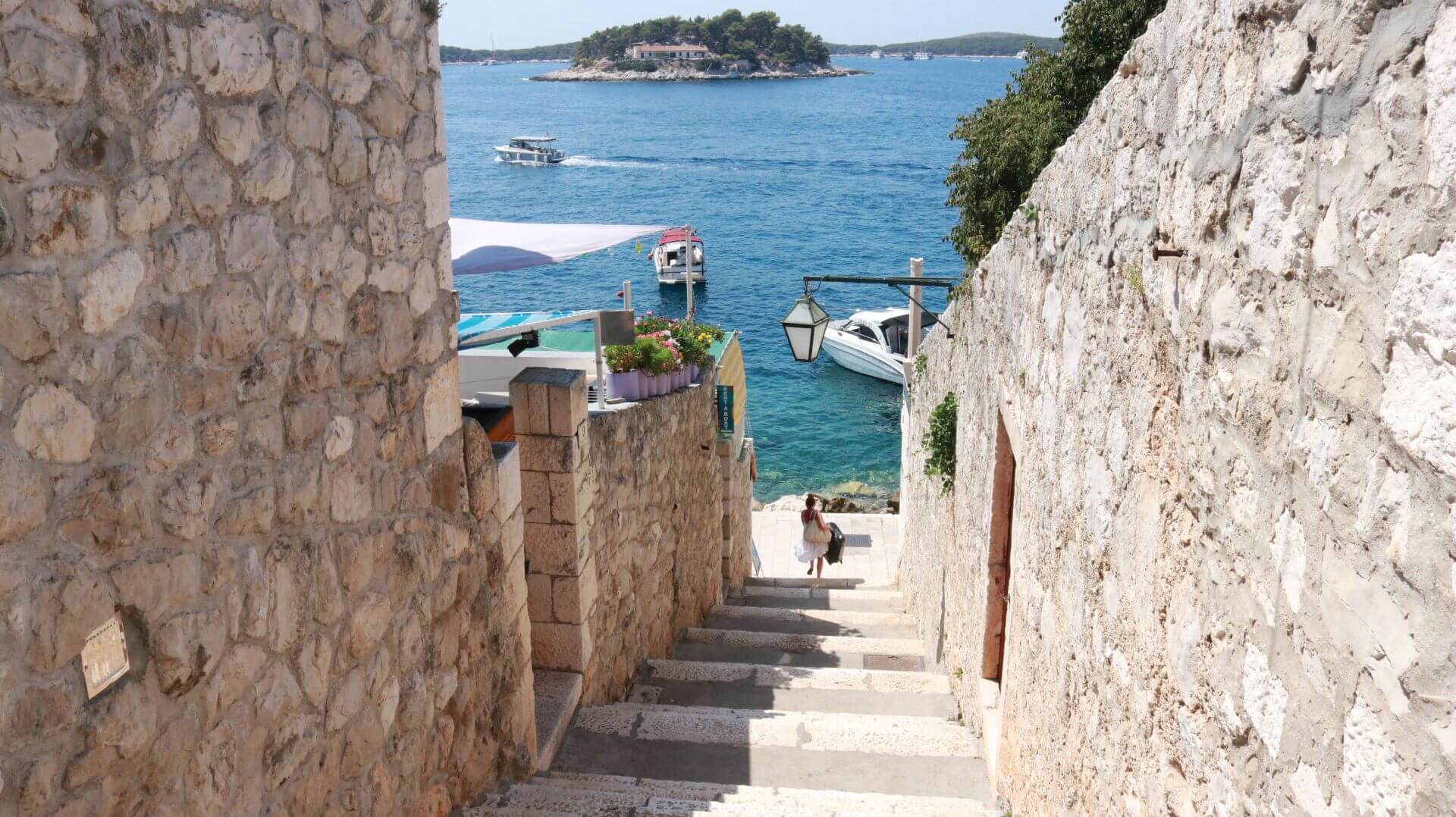
Back to the Adriatic © Nina Lelas
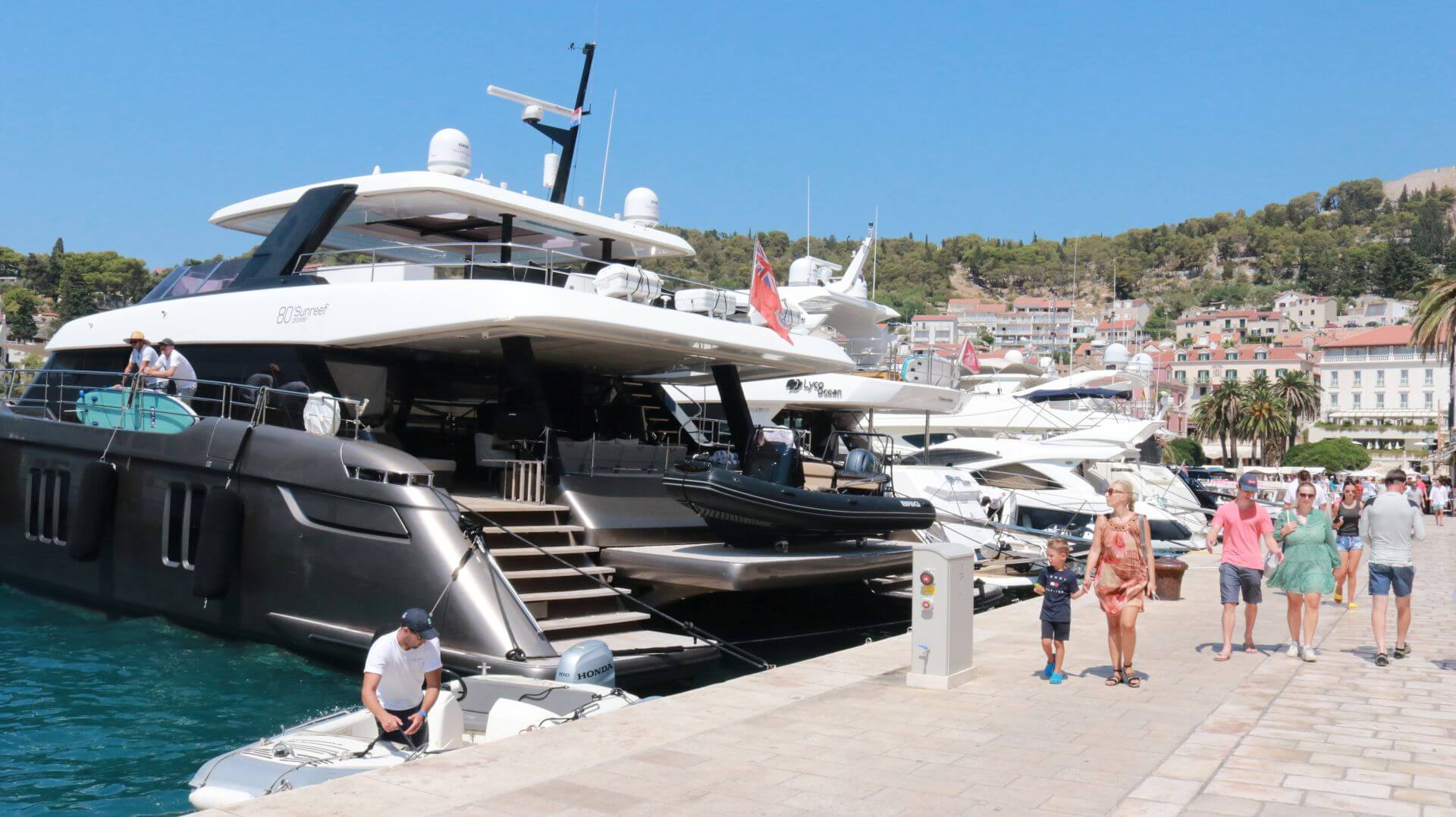
Yachts are nice but you don't have to drive, only relax when on catamaran © Nina Lelas
Learn more about Hvar on our TC page.
For more about traveling Croatia, follow TCN's dedicated page.
Croatian Poet Hanibal Lucić: Renaissance Genius from Hvar
August 14, 2021 - Meet Croatian poet Hanibal Lucić, one of the most respected poets from the country's renaissance period and a noble man from the island of Hvar. This is his story.
The richness of Croatia's heritage is evident not only in its many breathtaking buildings, statues and sights but also in its literature. Sadly, Croatian literature doesn't attract as much global attention as it should when compared to the global impact and various language translations that names such as Shakespeare enjoy. Not to mention antic Greek poets and writers, Italian authors such as Dante, and the list goes on.
Things are changing for iconic writers from Croatian history, such as 20th-century writer Miroslav Krleža as well as many of the modern, still active writers, thanks to the Croatian Literature site powered by the Croatian Ministry of Culture.
Prose writing doesn't have too many challenges for a professional translator when it comes to shifting the story from its original language to another, but you can be sure poetry is another story. If you read an English translation of ''The Flowers of Evil“ by Charles Baudelaire, instead of the original French version, did you really read Baudelaire or an author who made an adaptation of the poem into English in as much as was possible?
Either way, not much work done by Croatian poets is widely translated and known globally, but the Croatian poets themselves are known, and their former residences venues carrying their names and statues dedicated to them are part of the cultural offer Croatian destinations have to offer to their visitors.
In Hvar town, not too far from Veneranda, where the former church and famous former Hvar weather station lies, you can find a bust of a bearded man facing the Adriatic sea, and his eyes look as if they have that filter of lyricism, that poet-style introspect in observing the world. That should come as no surprise as the portrayed citizen of Hvar is non-other than Croatian poet, Hanibal Lucić, a nobleman from Hvar.
The exact date of his birth in 1485 isn't clear, but his date of death, December 14, 1553, is well recorded. The Croatian poet Hanibal Lucić was a renaissance poet as well as a playwright who authored the first secular Croatian drama titled ''Robinja'' (the slave woman). He served the Hvar Municipality back in the time when it was part of the Venetian Republic as a judge and a lawyer. His writings feature the Croatian Čakavski dialect (which distinctly uses the word ča for ''what''), and he wrote love poetry under the heavy influence of the legendary love poet Francesco Petrarca. Lucić was notoriously self-critical, and he even burned his work. Thankfully, his son saved his work and it was published in 1556, after his death.
Hanibal Lucić bust © Nina Lelas
In 2012, the National and University Library in Zagreb (NSK) posted an article in memory of Lucić, stating that he was the greatest writer of Croatian Renaissance poetry.
''We can gather from his literary works that he was exceptionally well-acquainted with classical literature, the Croatian Glagolitic and oral tradition, and the contemporary Italian and Croatian writing of his time. In his poetry, Lucić celebrated his love for women and for female beauty. In their aesthetic quality, Lucić’s poems represent a true masterpiece of Croatian renaissance lyric poetry. He describes beauty and love in the tradition of Petrarch, at the same time drawing on the oral tradition of Croatian love poetry,'' wrote NSK.
His poem „Jur ni Jedna na svit vila“ (No Other Nymph Upon This Earth), one of Lucić's most well-known poems, is an obligatory poem to read in the Croatian education system. You can learn more in this English version of a science paper by Tomislav Bodgan.
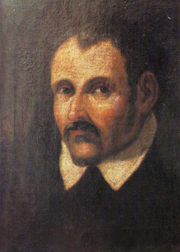
Portrait of Hanibal Lucić © National and University Library in Zagreb (NSK)
On Hvar, his summer residence still stands, and it's open to tourists to visit as its now the headquarters of the Hvar Museum.
''His summer house, the headquarters of the Hvar Museum, is a well-preserved example of the country houses of the Renaissance period, but with clear Gothic influences. Included in the museum is a reception room dedicated to the memory of Hanibal. The museum is also home to the local branch of the Croatian state archives. The opening hours are as follows: 09:00 -13:00 and 17:00 – 23:00 in summer, 10:00 – 12:00 in winter (by appointment),'' wrote Paul Bradbury for Hvar's dedicated Total Croatia page.
So, when in Hvar, do find time to visit the house but also don't forget to visit his bust and seek one of his pick-up lines that can help your banter with that pretty girl on the beach.
Learn more about Hvar on our TC page.
For more about Croatian history, follow TCN's dedicated page.
Grgur Bučić: The Croatian Scientist Who Measured Hvar's Sunshine Hours
August 13, 2021 - You came to Hvar expecting sunny days and you weren't conned. Meet and thank Croatian scientist Grgur Bučić who started the weather station on Hvar, one of the first in Croatia, which measured how sunny Hvar really is.
There's nothing worse than when a traveller on a short holiday on the Croatian coast ends up stuck in their hotel room because of bad weather. Unless you want to risk bad weather sabotaging your Adriatic swimming experience, and maybe if you're lucky to get rescued by indoor pools, you should definitely play it safe and go to Hvar. Known for years as the sunniest Croatian island, there couldn't be a safer place to count on a rain-free holiday.
During my time in Hvar town, the forecast showed rain and uncertain weather on the coast, but even the couple of clouds that formed over Hvar quickly dispersed and probably headed over to the mainland, to Split or elsewhere.
In addition to swimming in the Adriatic, Hvar has plenty of heritage and things to see, like the Spanish Fortress (Tvrđava Španjola), lots of churches (such as St. Stephen’s Cathedral), its historical theatre (the oldest municipal theatre in all of Europe, by the way), an archaeological collection in the former Dominican St. Mark’s Church, and the Natural History Cabinet in the Hanibal Lucić Summer Residence – to name a few. In fact, Hvar boasts more UNESCO heritage than any other island in the world.
One of the other interesting sites is also the Former Church and Monastery of St. Veneranda. As Hvar heritage writes, the church was built in 1561 for the needs of Greek Orthodox sailors who were in the service of Venice. Today, the site serves as an outdoor cinema.

The former church tower, the former weather station © Nina Lelas
Right next to it, back in 1858, famous Croatian nature scientist Grgur Bučić established a weather station, one of the first in the entire country. Being part of the Austro-Hungarian monarchy at the time, the station was part of the Austrian network of meteorological stations. Thanks to the measures taken under Bučić's expertise, the sunny days of Hvar are not a market scheme to attract tourists in need of clear sunny weather, but an actually very well-advertised scientific fact. In addition, for his experiments with sponge development, Bučić received global recognition, and seven species of sponges, crabs, and fish were named after him. He published articles regarding meteorology and oceanography and also studied insects and marine life. He also pioneered numerous archaeological digs across Croatia, including on Hvar.
Back in 2018, as TCN wrote, the station marked 160 years of existence. Organised by the Hvar Town Library and State Meteorological and Hydrological Service, this celebratory event revealed some interesting historical moments from and about the station. These include polar lights, storms, falling meteors, earthquakes, vineyards destroyed by hail, sunken ships, and epidemics. In 1884, based on data from Bučić himself, climatologist Julius von Hann (often looked upon as the father of modern meteorology) published his work ''Klima von Lesina'' (The climate of Hvar town), the first-ever such book on a Croatian town or area.

Grgur Bučić © MuzejHvar.com
Today, the Bučić tower is locked, and the path to the church now serves as an outdoor cinema, without that many interesting things to be seen. Could the tower be renovated and showcase the instruments this pioneer station used in the past? Perhaps, and it would certainly be a cool addition to the already extensive offer Hvar has for its visitors.
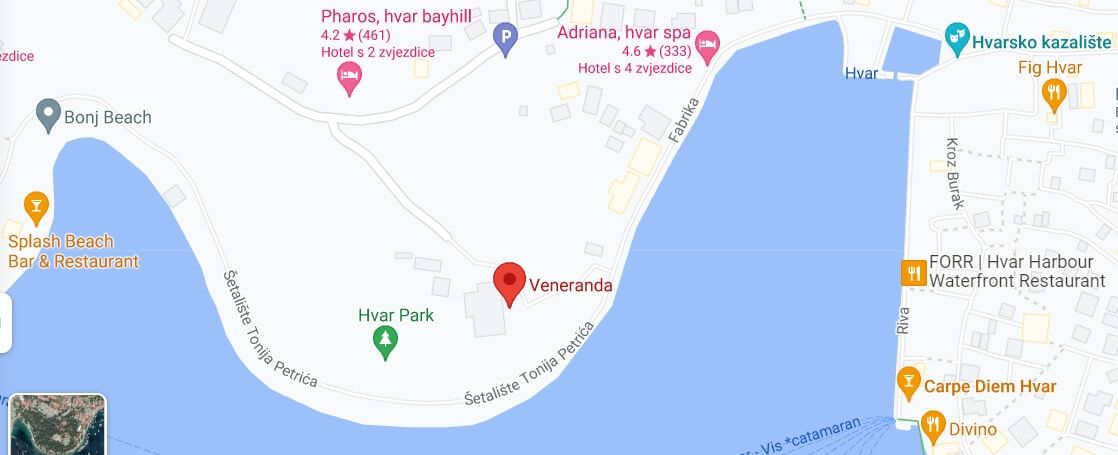
Veneranda, location of the station, screenshot / Google maps
While waiting to see what the future may bring, it's worth taking a look at this station, not far from the waterfront and the nearby beaches. Express some gratitude and dedicate a refreshing swim to Bučić himself, a brilliant man whose findings gave us scientific, statistical reassurance that Hvar is the sunniest place in all of Croatia.
Learn more about Hvar on our TC page.
For more about Croatian history, follow TCN's dedicated page.



